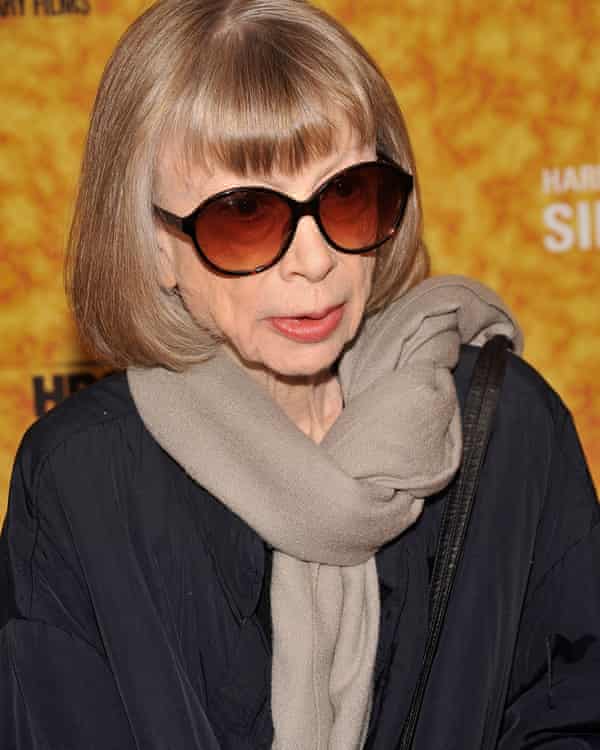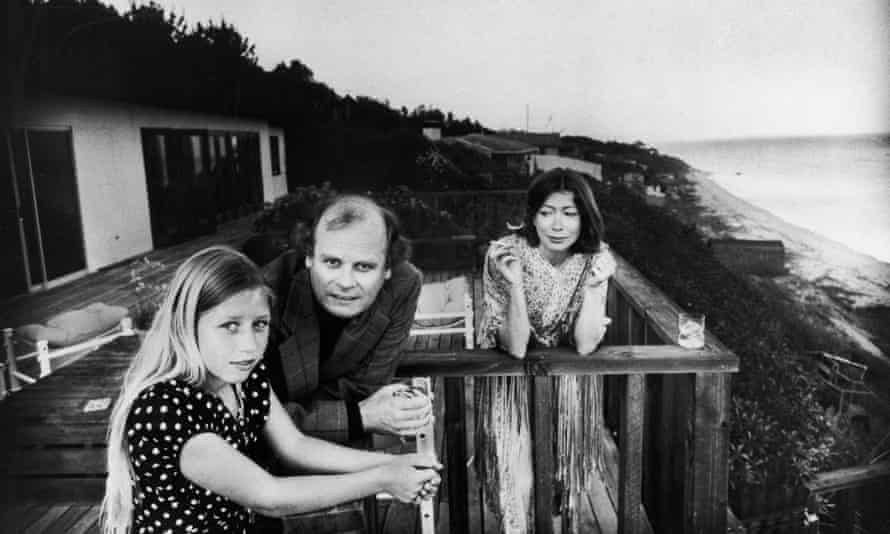Veronica Horwell
Thu 23 Dec 2021 21.22 GMT
The writing of Joan Didion, who has died 87, was mantra-like, mannered, even “set in its own modulations” (that was Martin Amis’s snipe). It was also unique and remarkable. Even the shape of her books was uncommon, the sentences spaced on pages as tall and narrow as king-sized cigarette packets.
She had practised that incantatory style since her mother had presented her, aged five, with a notebook and a suggestion that she calm her anxious self by writing. Her family had long been settled in California, then chiefly an agricultural state, a location that mattered to Didion’s story, and to her story-telling.
She was born in Sacramento, the daughter of Eduene (nee Jerrett) and Frank Didion, a finance officer with the US army, poker player, and, after the second world war, a real estate dealer. Joan was an army brat on her father’s stations, and her juvenile fantasies set out in that notebook were doomy – death in the desert, suicide in the surf.
The only printed influence on her work she ever cited was Ernest Hemingway, as she had typed out his prose in order to master the keyboard and his syntax: the exact placement of words was the basis of her style as it had been of his. “Grammar is a piano I play by ear,” she claimed. Studying English literature at the University of California, Berkeley, taught her to audit meaning, dissect language and triangulate evidence, and modified her original ambition, acting, into writing as performance.
Didion won Vogue’s Prix de Paris contest in 1956, and was rewarded with a copywriter’s job, dogsbodying with proximity to glamour, in New York, rising to associate features editor over eight years at Condé Nast. She said later that she had been in love with the city’s promise, excited by meeting whoever was in town — models, millionaires, magnates — but had remained an exiled westerner not at home in New York. With a portable typewriter perched on a chair in her almost empty apartment, she wrote a novel about the Californian rivers she so missed.

Those waterways are the real lead in her first novel, Run River (1963). John Gregory Dunne, a staffer on Time magazine and also a self-declared outsider, edited it. They married in 1964, and moved to Los Angeles temporarily, sure that his older brother, the producer Dominick Dunne, would be their entree to screenwriting. That scenario did not quite play out, and both had to turn to magazine journalism for an income.
Didion categorised some of her essays, with their first-person viewpoint and fiction-like fine detail, as “Personals”, but in fact they were about the world as seen by a social and political conservative from the last American generation to identify with adults. A tiny, unnerved and unnerving figure behind vast dark glasses, she was derisive of lax language and dismissive of unformed thought on both the left and right. She did not care to negotiate interviews with stars via their press agents.
She believed she could pass unnoticed anywhere: among the residue of the Hollywood studios and the creatives of the new music business; in arid valley towns and LA’s dustier districts; around the coagulating hippy counterculture in San Francisco. Her descriptions of her crippling social anxiety, her inability to make a phone call to get an assignment under way, did not accord with others’ memories of her taking laps of the room at swelegant parties.

Didion’s first book of collected journalism, Slouching Towards Bethlehem, published in 1968, the year in which she had a breakdown, established her reputation for cool and very slowly became a cult: as the writer Caitlin Flanagan remembered, Didion “had fans – not the way writers have fans, but the way musicians and actors have fans – and almost all of them were female”. That coolness was confirmed by her second novel, Play It As It Lays (1970), with its zomboid leading woman on Hollywood’s perimeter, so chilled a fiction that Didion’s editor, Henry Robbins, called her to ask if she was all right.
Possibly not, but she was getting by. The next year the couple had their first script onscreen, The Panic in Needle Park, and then their 1972 adaptation of Play It As It Lays flopped. Didion’s literary identity became clearer than that of her husband, with whom she shared preoccupations and phrasing, which added edge to their joint 1976 refettling of A Star Is Born to Barbra Streisand’s specifications.
Didion continued the essays, more personal yet, collected in 1979 as The White Album, and developed an idea she had had when trapped by paratyphoid in a hotel room during a Colombian film festival into A Book of Common Prayer (1977), her first fictional engagement with the role and image of the US in Central and Latin America.
At that point all the elements were in play that recurred in her fact and fiction. There was her concentration on the Americas – she had visited Europe and Israel, but disclaimed interest in them – and on the Hispanic influx into the US, which, as a Californian, she was aware of very early. Her books of reportage, El Salvador (1982) - “One morning at the breakfast table I was reading the newspaper and it just didn’t make sense,” she wrote of US press coverage of Salvador’s internal war, and immediately flew there to inspect the body dumps – and Miami (1987), were descriptions of equal and opposite cultural misunderstandings.
She felt that the US political process had become self-contained, exclusive of the electorate and, from the presidency of Ronald Reagan onwards, of reality itself – as depicted in the essays anthologised in After Henry (1992) and Political Fictions (2001) and her occasional 21st century pieces. This perception also fed into her best and most successful novel, Democracy (1984), which could be read as a romance, or – as was also true of her 1996 novel The Last Thing He Wanted – as an exploration of private connections to public power. The political could not have been made more personal.
The greater constant in Didion’s work, though, was the intersection of public and private mood with place – Hawaii febrile in tropical rain, Los Angeles fractious as the Santa Ana winds blew through. Readers came to know the homes she had passed through – the Malibu beach premises on the edge of the fire season burn zone, the “house in a part of Hollywood that had once been expensive and was now described as a ‘senseless killing neighbourhood’”, the Manhattan apartment with the Cy Twombly artwork, plus a travel itinerary of grand hotels.

They became even more familiar with the older California that she kept recalling all the way up to her memoir Where I Was From (2003), in which she finally admitted that her apprehension of her native state had been a misapprehension, an “enchantment under which I lived my life”. It was not the place she had thought it, and it never had been, all the way back to the settlers’ wagon trains and their encounters with rattlesnakes.
By then, she seemed to feel that reality was dispelling all enchantments from her life. The lives of Didion and Dunne had been mostly funded by their remunerative rewrites for the screen, although their joint “implied promise of quality” had been delivered in the adaption of Dunne’s novel True Confessions (1981), and rather less so in a prolonged project, Up Close and Personal, filmed in 1996 as a vehicle for Robert Redford.
They supported each other in public over their career compromises, but there had been fights and near-splits in the marriage. They once holidayed in the Royal Hawaian hotel “in lieu of filing for divorce”, and Dunne left to live alone in Vegas for a while when it was his turn for a breakdown. But it had survived, stronger than a mutual defence pact. Dunne died of a heart attack at their dinner table in Manhattan in 2003, a sudden exit that Didion described in The Year of Magical Thinking (2005), her book of grief and disbelief. It was critically admired for its honesty and clarity, and adapted for the stage.
Didion delayed Dunne’s funeral until their daughter Quintana had recovered from the pneumonia and septic shock that had put her into hospital intensive care. But her recovery was brief and Quintana died just before the book’s publication. Didion and Dunne had adopted the baby on the day of her birth in 1966, and called her after a Mexican state. She became a familiar player in their pieces, often quoted, described as an insouciant user of hotel room service when accompanying her mother on book tours.
In Blue Nights (2011), Didion suggested quite another story of Quintana as a Hollywood child who feared abandonment, was suicidal, diagnosed as manic depressive, and in adulthood had had difficult encounters with her birth family. However, the true subject of Blue Nights was Didion, alone and a long way from California; there could be no going back to places so changed. Her last works, South and West (2017) and Let Me Tell You What I Mean (2021) collected her “field notes” and early writing.



No comments:
Post a Comment